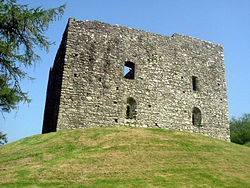William of Wrotham | |
|---|---|
| Archdeacon of Taunton | |
 Ruins of Lydford Castle, which was in William's custody | |
| Installed | 1204 |
| Term ended | c. 1217 |
| Predecessor | Robert de Geldford[1] |
| Successor | Peter[1] |
| Personal details | |
| Born | William |
| Died | probably before 2 December 1217 |
| Nationality | English |
| Parents | Godwin |
William of Wrotham or William de Wrotham[2] (died c. 1217) was a medieval English royal administrator and clergyman. Although a late 13th-century source says that William held a royal office under King Henry II of England (reigned 1154–1189), the first contemporary reference to William is in 1197, when he became responsible for, among other things, the royal tin mines. He also held ecclesiastical office, eventually becoming Archdeacon of Taunton, and served King John of England as an administrator of ecclesiastical lands and a collector of taxes.
William's main administrative work was naval. He was in charge of the royal fleet in the south of England in 1205, and was one of those responsible for the development of Portsmouth as a naval dockyard. He continued to be involved in naval matters until 1214 or later, but by 1215 he had joined the First Barons' War against John. After John's death in 1216, William returned to the royalist cause. He probably died in late 1217. Known to a contemporary chronicler as one of John's "evil advisers", William is said by modern historians to have had a "special responsibility for ports, customs, and the navy",[3] and was "keeper of ports", a forerunner of the office of First Lord of the Admiralty.
